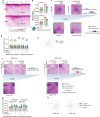Cis-regulatory evolution of the recently expanded Ly49 gene family
- PMID: 38844462
- PMCID: PMC11156856
- DOI: 10.1038/s41467-024-48990-y
Cis-regulatory evolution of the recently expanded Ly49 gene family
Abstract
Comparative genomics has revealed the rapid expansion of multiple gene families involved in immunity. Members within each gene family often evolved distinct roles in immunity. However, less is known about the evolution of their epigenome and cis-regulation. Here we systematically profile the epigenome of the recently expanded murine Ly49 gene family that mainly encode either inhibitory or activating surface receptors on natural killer cells. We identify a set of cis-regulatory elements (CREs) for activating Ly49 genes. In addition, we show that in mice, inhibitory and activating Ly49 genes are regulated by two separate sets of proximal CREs, likely resulting from lineage-specific losses of CRE activity. Furthermore, we find that some Ly49 genes are cross-regulated by the CREs of other Ly49 genes, suggesting that the Ly49 family has begun to evolve a concerted cis-regulatory mechanism. Collectively, we demonstrate the different modes of cis-regulatory evolution for a rapidly expanding gene family.
© 2024. The Author(s).
Conflict of interest statement
The authors have no competing interests.
Figures






Similar articles
-
Ly49G, but not Ly49C/I, is dispensable for diverse antigen-specific memory NK cell responses in H-2d and H-2b mice.J Immunol. 2025 Jul 1;214(7):1802-1813. doi: 10.1093/jimmun/vkaf105. J Immunol. 2025. PMID: 40381992 Free PMC article.
-
Machine-guided design of cell-type-targeting cis-regulatory elements.Nature. 2024 Oct;634(8036):1211-1220. doi: 10.1038/s41586-024-08070-z. Epub 2024 Oct 23. Nature. 2024. PMID: 39443793 Free PMC article.
-
Perceptions and experiences of the prevention, detection, and management of postpartum haemorrhage: a qualitative evidence synthesis.Cochrane Database Syst Rev. 2023 Nov 27;11(11):CD013795. doi: 10.1002/14651858.CD013795.pub2. Cochrane Database Syst Rev. 2023. PMID: 38009552 Free PMC article.
-
Genomic Ly49A transgenes: basis of variegated Ly49A gene expression and identification of a critical regulatory element.J Immunol. 2004 Jan 15;172(2):1074-82. doi: 10.4049/jimmunol.172.2.1074. J Immunol. 2004. PMID: 14707081
-
Evidence-based toxicology: a comprehensive framework for causation.Hum Exp Toxicol. 2005 Apr;24(4):161-201. doi: 10.1191/0960327105ht517oa. Hum Exp Toxicol. 2005. PMID: 15957536
Cited by
-
Single-cell transcriptome reveals the reprogramming of immune microenvironment during the transition from MASH to HCC.Mol Cancer. 2025 Jun 11;24(1):177. doi: 10.1186/s12943-025-02370-2. Mol Cancer. 2025. PMID: 40500691 Free PMC article.
References
MeSH terms
Substances
Grants and funding
- U01 HG009391/HG/NHGRI NIH HHS/United States
- R01 AI129545/AI/NIAID NIH HHS/United States
- U41HG010972/U.S. Department of Health & Human Services | National Institutes of Health (NIH)
- U41 HG010972/HG/NHGRI NIH HHS/United States
- R01HG007175/U.S. Department of Health & Human Services | National Institutes of Health (NIH)
- U01HG009391/U.S. Department of Health & Human Services | National Institutes of Health (NIH)
- R01 AG078958/AG/NIA NIH HHS/United States
- U24 ES026699/ES/NIEHS NIH HHS/United States
- U24 HG012070/HG/NHGRI NIH HHS/United States
- R01 HG007175/HG/NHGRI NIH HHS/United States
- P30 CA091842/CA/NCI NIH HHS/United States
- U24ES026699/U.S. Department of Health & Human Services | National Institutes of Health (NIH)
LinkOut - more resources
Full Text Sources
Molecular Biology Databases

